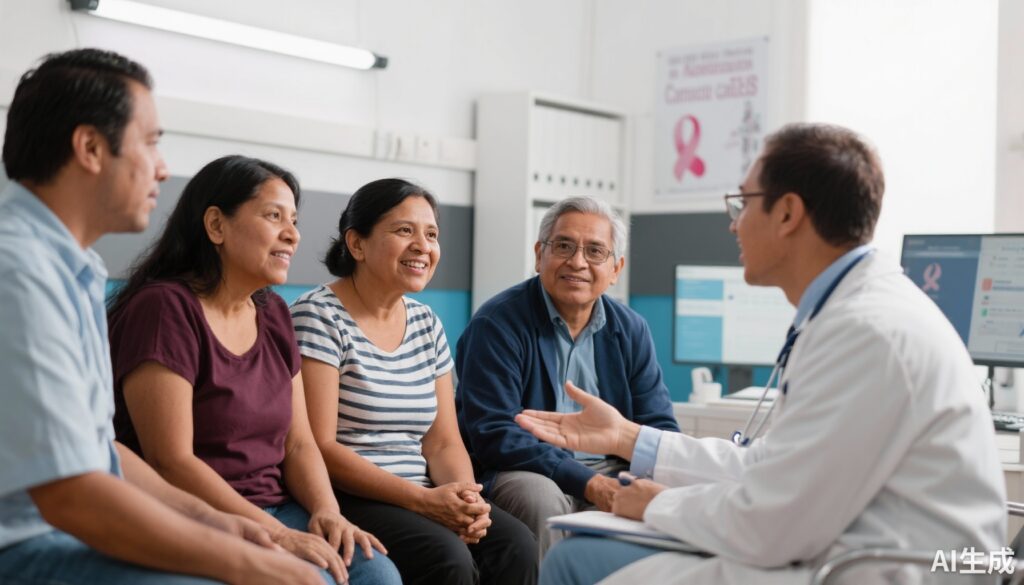Highlight
– Latino patients with melanoma often experience delays in diagnosis and treatment due to systemic and linguistic barriers.
– Patient advocacy and linguistically appropriate care serve as facilitators for timely melanoma care.
– Health insurance procedures and specialty referral delays are major barriers, contributing to advanced stage at diagnosis.
– Increasing awareness of melanoma and enhancing healthcare system navigation could improve outcomes for Latino patients.
Study Background and Disease Burden
Melanoma, though less common among Latino populations compared to non-Hispanic White individuals, poses a disproportionately high mortality risk in Latino patients. Despite a lower overall incidence, Latino patients frequently present with thicker, more advanced tumors at diagnosis, which correlates with higher mortality rates. Over the past decade, non-Hispanic White populations have experienced significant declines in melanoma mortality, largely due to the advent of effective therapies and earlier diagnosis. However, such improvements have not been equally realized in Latino communities, underscoring persistent disparities in melanoma outcomes.
Multiple factors contribute to these disparities, including but not limited to socio-economic barriers, limited healthcare access, linguistic and cultural differences, and a lack of melanoma awareness. Timely diagnosis and initiation of treatment are critical to improving survival; thus, understanding the facilitators and barriers experienced by Latino patients is vital to designing interventions aimed at eliminating these inequities.
Study Design
This qualitative study utilized reflexive thematic analysis of in-depth interviews with 20 Latino patients diagnosed with melanoma of any stage. Conducted from May to November 2023 in Los Angeles County, California, participants were identified through the California Cancer Registry, a component of the Surveillance, Epidemiology, and End Results (SEER) Program.
The study population included 65% females with a median age of 56.5 years (range 41-79). Half of the interviews were conducted in Spanish, reflecting the linguistic diversity within the cohort. The research employed a semistructured interview guide specifically designed to probe potential facilitators and barriers to timely melanoma diagnosis and treatment.
Key Findings
Analysis identified six thematic categories impacting timely melanoma care: two facilitators and four barriers.
1. Patient Advocacy as a Facilitator
Latino patients who actively advocated for their health care, sought information, and navigated healthcare systems proactively reported more timely access to diagnosis and treatment. Self-advocacy often involved requesting specialist referrals, seeking second opinions, and prioritizing follow-up appointments.
2. Linguistically Appropriate Care
Provision of care in the patient’s preferred language, often Spanish, emerged as a significant facilitator. Patients accessing linguistically tailored services reported better understanding of their condition, clearer communication with providers, and a smoother healthcare journey.
3. Health Insurance Procedures as a Barrier
Complexities and delays related to insurance authorization and coverage were prominent barriers. Patients frequently faced prolonged waiting times for approvals, leading to diagnostic and treatment delays. Navigating insurance bureaucracy without adequate support was a significant challenge.
4. Delays in Accessing Specialty Referral
Primary care providers’ referral processes and wait times for dermatology or oncology consultations were reported as substantial impediments. Limited availability of specialists and administrative hurdles exacerbated these delays.
5. Low Melanoma Awareness Prior to Diagnosis
Many participants described little prior knowledge or awareness of melanoma risks and symptoms. Lack of education contributed to delayed recognition of suspicious skin changes, postponing initial medical evaluation.
6. Lack of Linguistically Appropriate Care as a Barrier
In cases where language-concordant providers or interpreters were unavailable, patients experienced misunderstanding, reduced trust, and discomfort that impeded timely care.
Notably, 75% of participants were diagnosed at early stages (in situ or regional), suggesting some success in early detection despite barriers. The study’s nuanced insight into the intersection of cultural, systemic, and individual factors presents a critical foundation for targeted interventions.
Expert Commentary
Dr. Maria I. Gonzalez, an expert in dermatologic oncology with extensive experience in minority health disparities, emphasizes the importance of culturally and linguistically tailored healthcare services. “This study highlights that language access is not a mere convenience but a necessity for equitable melanoma care. Additionally, empowering patients to advocate for themselves can meaningfully reduce diagnostic delays,” she notes.
Current clinical guidelines recommend routine skin examinations and patient education about melanoma risk factors, but implementation varies widely. Integrating targeted public health campaigns and provider education focused on Latino populations could raise awareness and prompt earlier detection efforts.
Limitations of the study include the relatively small cohort size and geographic concentration in Los Angeles County, which might limit generalizability. However, the qualitative methodology provides rich, patient-centered perspectives critical for designing effective interventions.
Conclusion
Addressing disparities in melanoma outcomes among Latino patients requires multifaceted strategies. Facilitators such as patient self-advocacy and linguistically appropriate care enhance timely diagnosis and treatment. Conversely, structural barriers like insurance-related delays, specialty referral challenges, and low melanoma awareness hinder effective care delivery.
Healthcare systems must prioritize linguistic and cultural competence, streamline insurance and referral processes, and engage in community outreach to elevate melanoma awareness. These measures, combined with supporting patient empowerment, hold promise to reduce melanoma mortality disparities in Latino populations.
Further research should explore scalable interventions in diverse Latino communities and evaluate their impact on melanoma outcomes. Clinicians are encouraged to adopt culturally sensitive practices and proactively address barriers to ensure equitable melanoma care for Latino patients.
References
1. Miller KA, Marìn P, Aguero R, et al. Facilitators and Barriers to the Timely Diagnosis and Treatment of Melanoma in Latino Persons. JAMA Dermatol. 2025 Oct 1. doi:10.1001/jamadermatol.2025.3620
2. American Cancer Society. Melanoma Skin Cancer – Cancer Facts & Statistics. 2023.
3. Glazer AM, Winkelmann RR, Chen S, et al. Disparities in Early Detection of Melanoma in the United States. Journal of the American Academy of Dermatology. 2019;81(5):1056-1063.
4. U.S. Department of Health and Human Services. National CLAS Standards: Culturally and Linguistically Appropriate Services in Health and Health Care. 2020.


